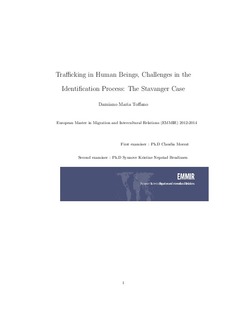| dc.description.abstract | Migration is a very diversified topic, where both positive and negative sides
merge together providing aspects of complexity and a state of uncertainty that
have repercussions on related arguments such as the case concerning Trafficking
in Human Beings (THB).
The huge amount of actors involved within the trafficking networks, the complex
cases it generates and the particular characteristics of this crime, including
its transnational nature, provide a sense of confusion to those people who decide
to improve their knowledge for professional reasons or for a sense of moral duty.
In order to facilitate this approach, I decided to research on the mechanism
that lies behind the entire process of THB, starting from the protection to the
rehabilitation of the victims. This is the identification process.
The reason why I chose this particular phase of the process is related to
the THB characteristics that define, in accordance to the International Labour
Organization (ILO), trafficking in human beings as one of the most difficult
and “hidden” phenomena to measure.
Indeed, in despite of the huge efforts put in place by the States, the daily
work NGOs perform at the local level, and finally, the high cohesion in terms of
international cooperation, this crime is still able to survive and bloom, thanks
to some lacks in the legal system and the deep complicity of uninterested people,
who try to avoid any risk embracing everything the market can offer them.
This case is particularly highlighted by the sexual exploitation of victims
(HTSP), which includes the most flourished typology of THB market within
the European area. Indeed, “approximately 120.000 women and children are
trafficked into the European Union every year, whereas a range from 700.000 to an astounding 4.000.000 women and children seems to be trafficked annually”.
Furthermore, this situation is worsened by the slavery as a product of such
ill market, in which the degraded role of the person remembers very well the
marxist inversion of the “rei-fication”, as referred by the official ONU Supplementary
Convention on Slavery Abolition in 1956: “Slavery means [....] the
status or condition of a person over whom any or all of the powers attaching
to the right of ownership are exercised, and "slave" means a person in such
condition or status”. At this point, it can be understood how the relevance
of the issue is both related to its quantity (the dimension of the phenomenon)
as well as its quality, since the impact on people have explosive effects on the
economical situation, health sector and democratic institutions of the country
in which the exploitation is performed. In addition, this phenomenon should be
contextualized in the greater market of Globalization that, paraphrasing Bauman’s
words, is polarizing instead of distributing5 resources and goods in those
places where the economy is able to support and attract the demand. The
city of Stavanger, with its international dynamics, demonstrated to have all the
qualities for being taken as a “model” city in order to research on trafficking for
sexual purpose (HTSP) and moreover, a place with a unique sensibility in terms
of vulnerable people. | nb_NO |

